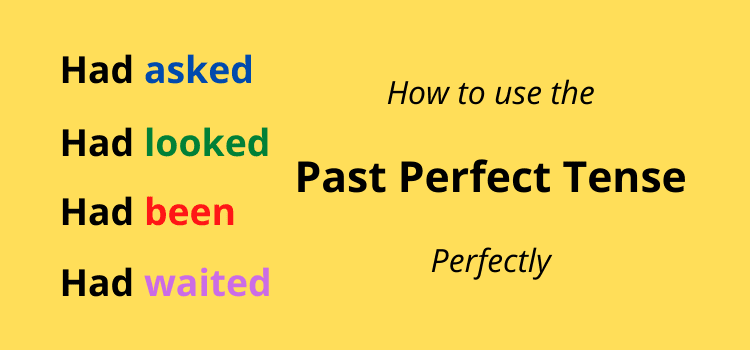
The past perfect tense is very useful in writing. We use it to show that an action occurred before another action in the past.
It is a tense that concisely creates order without using time clause expressions like, and then or afterward.
Although it is a perfect tense because it uses the auxiliary, had, it has no relationship at all with the present perfect tense.
The best feature of past perfect, which is sometimes called pluperfect, is that it is super easy to use for any writer.
The past perfect simple structure
Because it uses the auxiliary had for both singular and plural subjects, the tense is easy to construct.
You use had + the past participle of the main verb for all uses.
I had worked. She had waited.
We had driven. You had tried.
For negative sentences, negate the auxiliary verb.
I hadn’t tried. They hadn’t invited.
It hadn’t succeeded. He hadn’t driven.
For the question form, you invert the auxiliary verb and subject.
Had they forgotten? Had you lost?
Had he stopped? Had it rained?
How do you use past perfect tense?
The past perfect is the part of a sentence that says something happened before another action.
The second action mostly uses the past simple.
However, the order of the sentence doesn’t change the order of events.

You can use the past simple before or after the past perfect.
Look at the following past perfect tense examples.
After I had written my story, I gave it to my editor.
I gave my story to my editor after I had written it.
In both sentences, it is clear that the subject wrote the story and then gave it to the editor.
When you want to indicate a specific time between events, you can add a time clause.
It can be a short time or a long time.
They had arrived only a few minutes before we did.
She had been out of work for two years before she found a new job.
Past perfect continuous
We use the continuous form to express an ongoing action before a later action.
The structure is had been + present participle.
We had been waiting for two hours before the train finally arrived.
I had been working there for only two months before the company went broke.
Her fitness improved because she had been training hard after her injury.
Traps to avoid
The most common error is when there is no second clause or finisher to a sentence.
We had painted the house. Incorrect
This sentence doesn’t make sense because we don’t have the extra information about why or when.
We had painted the house two weeks before we moved in. Correct
You always need a second clause, but it doesn’t need to be explicit using a simple past phrase.
They had left. Incorrect
They had left a few minutes before us. Correct
The easiest way to be right all the time is to make sure there is a “something else happened” clause in your past perfect sentence.
Extended use of the past perfect
It is possible to remove the second repeated subject and linking words, including before and after, using the gerund form.
Although the gerund is sometimes considered weak in writing, it does have some worthwhile uses. The gerund, having, replaces the first subject.
Look at these examples to see how you can make your sentences more concise.
He had waited for three hours before his flight finally departed for London.
Having waited for three hours, his flight finally departed for London.
After I had started my new job, I felt more financially secure.
Having started my new job, I felt more financially secure.
Had had sentences
When we use the verb have in a past perfect sentence, it creates what is called a had had sentence.
We often use contraction to lessen the harshness of the phrase.
After I had had three serves, I was extremely full!
After I’d had three serves, I was extremely full!
But there are situations where there can be a quadruple occurrence, as in this famous expression.
All the faith he had had had had no effect on the outcome of his life.
It’s a mouthful, but it is grammatically correct.
Summary
The past perfect tense is one of the easiest to learn how to use in your writing.
You are not going to use it a lot. But it is a great tool to have on hand for sequencing in fiction writing.
For article writing, you can use it for cause and effect situations like finding a fault in a product after it had been launched.
As with all structures, don’t overuse it. But it gives you a way to add variety to your writing.
Related reading: When To Write Using Present Perfect vs Past Simple For Fiction
Share This Article



Thank you for your clear and concise examples.
Thanks for a very useful post. I appreciate your good examples. I will be posting the link on my blog.
Thank you very much for the usefull posting. Have a beautiful weekend. Michael
Thanks for that. You refer to the simple past tense in this article. When I was at school we were taught it was called the imperfect tense. Is this an American way of refering to this tense, or has it changed in the many years since I went to school?
I’m not sure it’s a US or UK change in titles. When I was at school, the simple past was called the preterite. The past perfect was the imperfect for me too. Who uses these words now? I think it is just part of a continuing trend to modernize English grammar. One of my favorite grammarians, Michael Swan, avoids using terms like the gerund and present participle. He calls them all, ing words. Now that is simplifying.